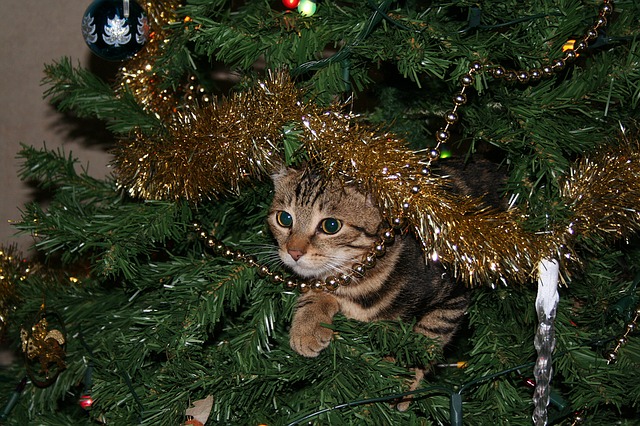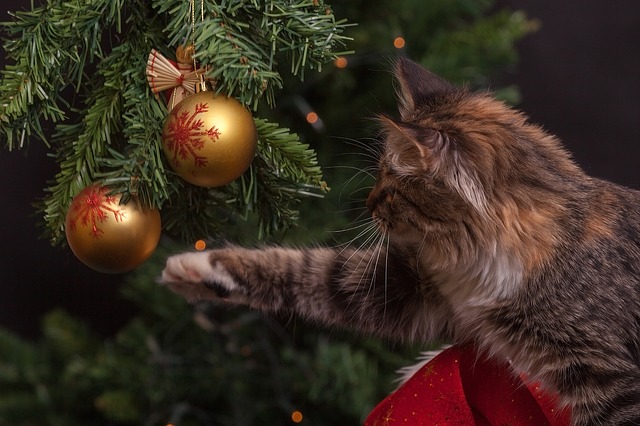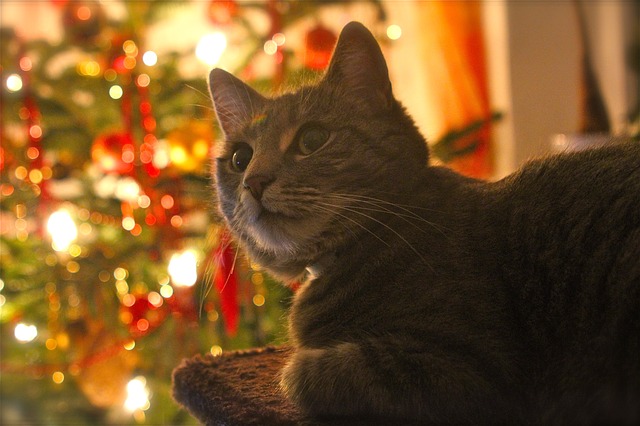
Follow our 10-step guide to avoid a Christmas tree cat-astrophe
Christmas is such an exciting time of year for us and our pets, however cats and Christmas trees can be dangerous combination. Sparkling lights and pretty baubles on a tree can provide too great a temptation for an inquisitive cat to resist. Whilst cases involving Christmas trees aren’t one of the leading causes of cat emergencies over the festive season, they do present a risk.
It’s for this reason we’ve prepared the ultimate guide to a cat proof Christmas tree. For more information on potential dangers for cats over the festive season check out our infographic.
1. Choose your tree carefully
Real fir trees are mildly toxic and may produce oils which can cause irritation to a cats mouth or stomach. Fallen needles could, theoretically, puncture your cats intestines if swallowed, causing potentially life threatening injuries.
If you have your heart set on a real tree, choose one with low drop or no drop varieties. Keeping the tree trunk in water may help to reduce further needle-drop, just remember stagnant water can be harmful if ingested so always cover it up.

2. It's all about the base
If you want to avoid a cat-astrophe – in other words, your tree falling over with your cat in amongst the branches – place it in a solid, wide and unwavering base. Some people like to line the trunk of their tree with tin foil to deter their cat from climbing. Depending on the trees size, it’s also worth fixing the tree to the wall or ceiling. Smaller trees may also be less tempting for a cat to climb, and less likely to cause damage or injury if knocked over.
3. Location, location, location
Location, location, location – it’s the mantra of estate agents the world over. But it’s also critical for cat owners intent on putting up a Christmas tree.
Avoid areas with shelves, settees and other furniture nearby as your cat will potentially use these as a launchpad to dive into it. Placing the tree in the corner of the room can reduce access and improve stability if the tree is rocked. Your cat should not be left unattended with the tree, so consider placing it in a room that you can close off when you are out or asleep.
4. Leave your tree bare for a while
It’s worth putting your tree up bare for a few days. This will give your cat the opportunity to explore, investigate and, ultimately, get used to it – without decorations and tinsel catching her eye.
5. Decorations to steer clear of
Tinsel is very dangerous to cats if eaten. If they don’t choke on it, it can get stuck in their intestines causing severe damage to their internal organs, which can be life-threatening.
In one recent case, a cat called Ginge had to undergo life-saving surgery after vets found 3ft of tinsel inside him. Astonishingly, it been stuck there for three weeks. His owner said she’d seen Ginge steal the decoration but hadn’t thought anything of it until he kept being sick.
Cats are also attracted to shiny baubles that glow and dangle so these should be avoided. Glass or breakable ornaments may splinter into shards when chewed. If swallowed, these can cause irritation, perforation, or even blockages.
Other things to avoid are decorations with little metal hooks, festive plants such as holly and mistletoe, salt dough ornaments, and artificial snow as it can contain potentially dangerous chemicals.
6. Decorations to consider
There are plenty shatterproof Christmas ornaments out there and you could also try using simple wood, felt, and paper decorations.
7. Be careful with fairy lights and electrical cables
Cats have been known to give themselves a nasty shock by chewing through the wires of fairy lights. Place lights towards the centre or top of the tree, and cover the end of the wire that plugs into the wall with a cord protector. Always unplug the lights when you are out or asleep.
8. Keep it all up high
If possible, place the decorations and lights you do decide to use in the upper two-thirds of the tree. Some cats won’t show an interest in anything that’s out of their reach. As an additional precaution try tying the ornaments to your tree to make sure they are extra secure.

9. Avoid other holiday hazards
Be sure to keep food and plants that can be poisonous out of reach. Chocolate contains a stimulant called theobromine that can lead to organ damage and seizures if ingested. Don’t hang chocolate treats on your tree and never leave chocolate bars or gifts containing chocolate lying underneath it.
Mistletoe, Poinsettas, Amaryllises, Cyclamen and Lillies, amongst others, are all poisonous to pets and should be kept well out of reach. See our round-up of dangerous holiday plants here.
Finally, steer clear of snow globes. These have been known to contain antifreeze which is highly toxic to cats.

10. Are there any other products to help me?
Some cat owners have been known to coat their tree with citrus oil extract and strong smelling sprays such as bitter apple. However, some of these can be toxic to cats so be careful. There are other products on the market that have been specifically designed to prevent cats from climbing Christmas trees but their safety and reliability is not known.
